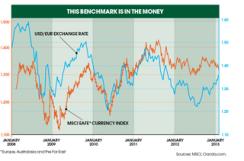Now that institutional investors are giving more thought to currencies as an asset class, one question is what to use for benchmarking. Equity managers have the S&P 500 index; bond investors have the Barclays Capital U.S. Aggregate Bond Index. What tools do foreign exchange traders use?
There now exists as wide an array of benchmarks for foreign exchange as there are investment strategies. The providers include Cürex Group, which last year formed a partnership with FTSE to produce forex indexes; MSCI, divested by Morgan Stanley in 2009; and Deutsche Bank’s huge foreign exchange operation.
Compiling the S&P 500 is relatively easy because it uses closing prices, but there’s nothing similar for foreign exchange, which lacks any central pricing mechanism. As a result, forex indexes show about as much variety as currencies themselves. One key difference is weighting; another is whether the index is primarily designed for hedging or achieving profits.
Deutsche Bank’s main Group of 20 currency index, for example, is trade-weighted: The amount of each country’s currency is determined by its foreign trade volume. Not surprisingly, MSCI uses the country’s weighting in the MSCI equity indexes. Cürex opts for a simple equal weighting, starting all countries on the same footing and restoring that balance weekly.

Cürex establishes prices for 200 currency pairs on its own electronic network and uses them to build basket indexes, Dale says. He sees three uses for the indexes. The first gives customers a benchmark for trading spot currency pairs. After the recent spate of lawsuits over foreign exchange pricing, this provides instant transaction analysis. The second helps investors measure how much yield they’re earning on currencies, using daily accrued net interest, or DANI, which allows them to overlay a currency exposure on a commodity or bond in what Dale calls an “asset class enhancer.” The third involves liability-driven investment strategies that aim to align assets with liabilities; for example, a pension plan might pay out in one currency but earn in several.
Raman Subramanian, executive director of index research at New York–based MSCI, says his company offers two groups of pure foreign exchange indexes — hedged and unhedged. A third group combines share performance with forex returns. An investor hoping to see a benchmark for equity returns with currency exposure would use the MSCI Hedged indexes, which show the pure equity return without currency. In the pure currency area, MSCI has different indexes for the G-20, the Group of Eight and 21 emerging-markets currencies, as well as the EAFE Currency Index, which covers Europe, Australasia and the Far East. They reflect yield on currencies in addition to appreciation and depreciation.
Then there are the strategy indexes, which investors use to produce profits as if currencies were an asset class — a long-debated topic. One is a carry trade strategy that entails looking for a country with a high yield relative to another currency and investing in that currency pair. The second use is in value strategies: Investors seek currencies that are undervalued or overvalued as measured by purchasing power parity; if a currency is underpriced, they buy it. The third is a momentum strategy that tracks whether a currency is on a downward or upward slope and invests accordingly.
Subramanian says his company’s hedged indexes are among its most popular because many buy-side clients already invest internationally using an MSCI index as a guide to asset allocation by country and region. “If you are an EAFE manager and you are worried about the volatility of EAFE currencies, then you will benchmark your portfolio against the EAFE hedged indices,” he explains.






